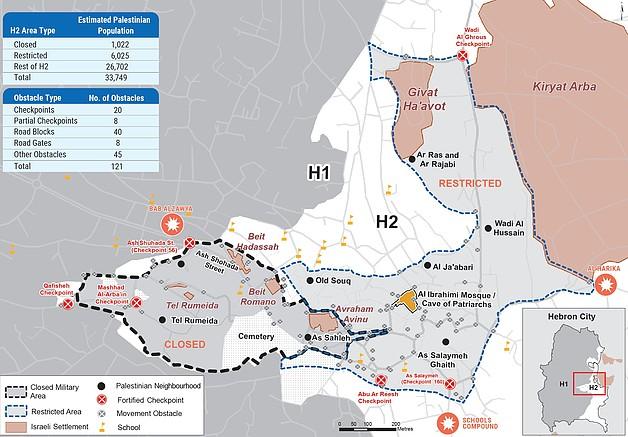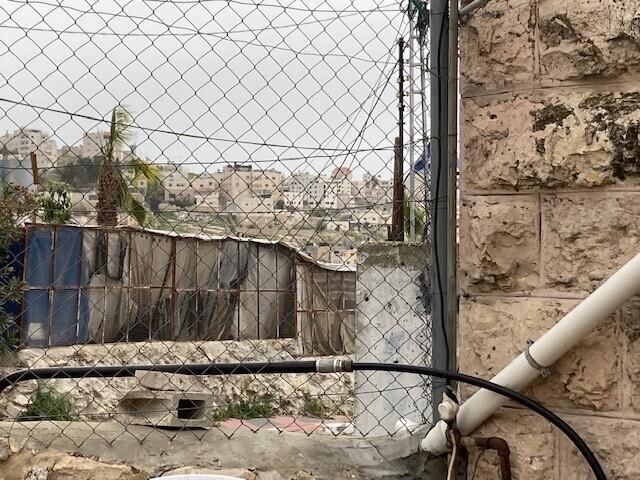Hebron is a divided city ever since the Wye Plantation accords of 1997. In the Palestinian part (H1) live about 165,000 Palestinians. In the part under Israeli control (H2), with Hebron’s Old City at its center, live about 35,000 Palestinians. The entire Old City has been declared either ‘closed military zone’ or limited in access, and the Palestinian residents there are subject to the harsh restrictions of vehicular traffic and trade prohibitions. Only 48 vehicles belonging to Palestinian residents of H2 are allowed entry into the Old City.
Outside the settlement Kiryat Arba (adjacent to Hebron) and its extensions, now live about 800 Jews in the Old City, in several main areas (see maps following). They are free to move around in the entire area, and expand their realm of control with the encouragement of the state and the help of the Israeli army. The expansion of Jewish settler-colonization in Hebron’s Old City entails the erection of military checkpoints and posts, further preventing Palestinian movement. The Palestinians remaining in the Old City suffer systematic violent assaults and harassment at the hands of the Jewish settlers, and all backed up by the ‘security’ forces. They live behind metal-screened windows. At any given moment soldiers may detain and arrest any Palestinian – man, woman or child.
The UN Office for the Coordination of Humanitarian Affairs (OCHA) has listed 18 permanent checkpoints manned by Israeli soldiers, 14 checkpoints manned at times, and another 70 permanent barriers (concrete walls, concrete blocks and locked gates
manned by Israeli soldiers, 14 checkpoints manned at times, and another 70 permanent barriers (concrete walls, concrete blocks and locked gates ) disconnecting the ancient center, the heart of Hebron, from the rest of the city
) disconnecting the ancient center, the heart of Hebron, from the rest of the city
Hebron under Israeli control (H2)
Hebron has experienced many and consistent acts of Palestinian and Jewish terrorism, such as the massacre during the 1929 rioting, when 66 Jews, living in Hebron, were murdered, and the massacre that Baruch Goldstein perpetrated on Purim Day 1994 when 125 Muslims in prayer were murdered inside the Al Ibrahimi Mosque (Cave of the Fathers).
All of these and more have become bleeding turning points in the city’s history.
After the massacre at the Cave of the Fathers, Israel instated a policy of extreme physical and legal segregation between Jews and Muslims. Whereas the Jewish settlers move unrestricted everywhere, Palestinian movement both on foot and in vehicles has been severely restricted around the market, the Casbah, and the main streets of the Old City
Furthermore, closure orders were issued for hundreds of shops. Thus the bustling center of Hebron collapsed economically – businesses and shops were closed and thousands of Palestinian residents left their homes. In order to enter their homes, go shopping, or to school, the Palestinians of the Old City now have to cross fortified checkpoints on foot, that are closed off at times without warning.
orders were issued for hundreds of shops. Thus the bustling center of Hebron collapsed economically – businesses and shops were closed and thousands of Palestinian residents left their homes. In order to enter their homes, go shopping, or to school, the Palestinians of the Old City now have to cross fortified checkpoints on foot, that are closed off at times without warning.
Even schoolchildren are not protected – numerous incidents have been documented of Israeli army patrols throwing teargas grenades into schoolhouses or in their vicinity, following suspicions or actual stone-throwing at military patrols. In 69 such incidents in 2019, about 1000 schoolchildren and teachers have been injured.
The Jewish settlers in Hebron are trying all the while, and rather successfully, to expand Jewish settlement at the Old City by purchasing houses in Palestinian neighborhoods such as the ‘Dispute House’, `Rachel and Leah House`, and the `Machpela House`. The structures are renovated and populated increasingly. The acquisition is usually performed through straw agents. In 2020 new construction plans for Jews have been approved inside the Hebron market area, and at the same time, a construction permit has been issued for the project called “Ezekiah Quarter”, in spite of a court order to stop the works. If these two projects will indeed be completed, they are expected to double the Jewish populace inside Hebron
The map of the part of Hebron under Israeli control (H2) : barriers and inhabitants (Courtesy of OCHA)

Jewish settlements and checkpoints in the old city of Hebron (Courtesy of Btzelem)
The Tel Rumeida neighborhood
is one of the most sensitive areas in the western part of the Old City. It is declared a closed military zone and access to it is extremely limited for Palestinians.
The first settlement was created in the heart of this neighborhood as early as 1986. Now it already contains five spots of Jewish settlements, including army posts, in addition to the many checkpoints and barriers. In Purim 2016, two young men of Hebron stabbed a soldier at an Israeli army post at Tel Rumeida. One of the terrorists was shot to death by the soldiers, and the other wounded and then shot by Elor Azaria who was convicted of his killing.
In 2018, an archeological park identified with Biblical Hebron was opened to visitors on the western edge of Tel Hebron neighborhood. It is backed up with a new settlement and an army post located in an ancient olive grove belonging to a Palestinian resident. The park is the finishing point of a new tourist heritage route, far from the Cave of the Fathers. Thus the settler-colonists act on behest of the government policy and with the army’s help, to surround and isolate the Palestinian residents living in the ancient homes of this neighborhood, and make them leave
Video – Bassem Abu Aisha speaks of December 19, 2020 Saturday events at Tel Rumeida,

MachsomWatch activity in the Hebron area began in 2004, and weekly vigils, some bi-weekly, visit the many checkpoints surrounding the Old City.
We maintain contact with the Palestinian residents, with the kindergartens and schools in the Tel Rumeida neighborhood of the Old City, and especially document unbearable life conditions, injustices, and violence perpetrated by the Occupation policy dictated by extremist settlers.

